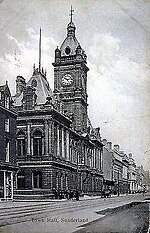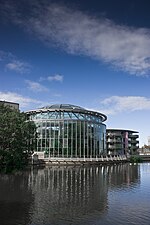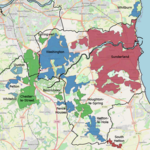Sunderland

Sunderland ( (listen)) is a port city in Tyne and Wear, England. It is the City of Sunderland's administrative centre and in the historic county of Durham. The city is 10 miles (16 km) from Newcastle-upon-Tyne and is on the River Wear's mouth to the North Sea. The river also flows through Durham roughly 12 miles (19 km) south-west of Sunderland City Centre. It is the only other city in the county and the second largest settlement in the North East after Newcastle upon Tyne. Locals from the city are sometimes known as Mackems. The term originated as recently as the early 1980s; its use and acceptance by residents, particularly among the older generations, is not universal. At one time, ships built on the Wear were called "Jamies", in contrast with those from the Tyne, which were known as "Geordies", although in the case of "Jamie" it is not known whether this was ever extended to people.There were three original settlements by the River's mouth which are part of the modern-day city: Monkwearmouth, settled in 674 on the river's north bank with King Ecgfrith of Northumbria land granting to Benedict Biscop to found a monastery which, together with Jarrow monastery, later formed the dual Monkwearmouth-Jarrow Abbey; Sunderland, settled in 685; and Bishopwearmouth, founded in 930. The later two are on the Wear's southern bank. The second settlement on the wear's mouth grew as a fishing settlement and later as a port, being granted a town charter in 1179. The city started to trade coal and salt with ships starting to be built on the river in the 14th century. By the 19th century, with a population increase due to shipbuilding, port and docks, the town absorbed the other two settlements. Following the decline of its traditional industries in the late 20th century, the area became an automotive building centre. In 1992, the borough of Sunderland was granted city status.
Excerpt from the Wikipedia article Sunderland (License: CC BY-SA 3.0, Authors, Images).Sunderland
John Street, Sunderland Ashbrooke
Geographical coordinates (GPS) Address Nearby Places Show on map
Geographical coordinates (GPS)
| Latitude | Longitude |
|---|---|
| N 54.906 ° | E -1.381 ° |
Address
John Street 55
SR1 1QH Sunderland, Ashbrooke
England, United Kingdom
Open on Google Maps










